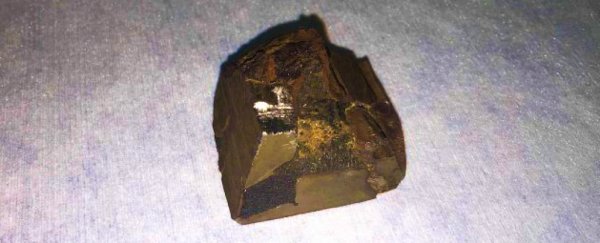A small fragment of rock found lying in a field in Gloucestershire in the UK may not have looked like much to the casual passerby, but it could contain vital information about the formation of the Solar System – and the origins of life itself.
That's because it did not form here on Earth, but hails from somewhere out past the orbit of Mars. Kicked out by gravitational interactions or a collision between asteroids, the fragment tumbled across the vastness of space to end up punching through our atmosphere to land on Earth as a meteorite.
What has come to be known as the Winchcombe meteorite may, however, be no ordinary meteorite. Scientists are now conducting analyses to determine its composition, in the hopes of learning more about where it came from, and how it formed.
"The internal structure is fragile and loosely bound, porous with fissures and cracks," said microscopist Shaun Fowler of Loughborough University in the UK.
"It doesn't appear to have undergone thermal metamorphism, which means it's been sitting out there, past Mars, untouched, since before any of the planets were created, meaning we have the rare opportunity to examine a piece of our primordial past."
The small fragment, part of the same meteorite that fell in Winchcombe in March, is around 4.6 billion years old – that's about the same age as the Solar System. That means it formed from the same cloud of dust and gas that birthed the Sun and the planets.
While the Solar System's planets have since undergone significant events and transformations, the Gloucestershire meteorite was just sort of hanging out unmolested in the asteroid belt between Mars and Jupiter. Its loosely aggregated construction meant that it has not experienced the compacting from repeated collisions.
That is, until it landed on England. Its arrival created a stir – not only was it the first meteorite to be recovered on the continent in 30 years, but it turned out to be a rare kind, known as a carbonaceous chondrite.
That means it's a rocky meteorite, rather than iron, made up primarily of carbon and silicon. These materials are less likely to survive the rigors of atmospheric entry than iron rocks; this is why carbonaceous chondrites are few and far between.
The blackened chunk of space rock will be undergoing a suite of analyses, including electron microscopy, vibrational spectroscopy, and X-ray diffraction. These techniques will help reveal the physical structure of the rock, as well as what it's made of. We already know a little, but the scientists are looking for hidden details.
"The bulk of the meteorite is comprised of minerals such as olivine and phyllosilicates, with other mineral inclusions called chondrules," Fowler said.
"But the composition is different to anything you would find here on Earth and potentially unlike any other meteorites we've found – possibly containing some previously unknown chemistry or physical structure never before seen in other recorded meteorite samples."
Less than five percent of all meteorites recovered on Earth are carbonaceous chondrites, but they're highly sought: they're rich in organic materials, and scientists believe they may contain clues as to the origins of organic matter here on Earth.
Other such chunks of space rock have yielded tantalizing clues about the origins of the building blocks of life, as well as water, but with so few available for study, researchers are hungry for more.
"Carbonaceous chondrites contain organic compounds including amino acids, which are found in all living things," said astrochemist Derek Robson of the East Anglian Astrophysical Research Organisation (EAARO), who found the meteorite.
"Being able to identify and confirm the presence of such compounds from a material that existed before the Earth was born would be an important step towards understanding how life began."
The team's analysis is ongoing.
